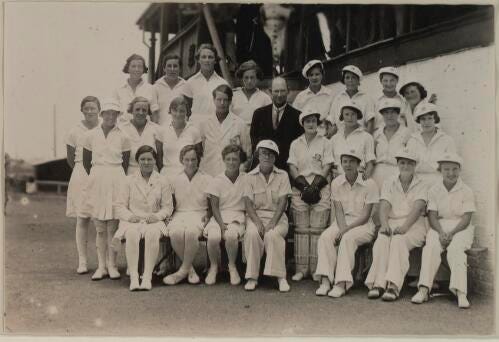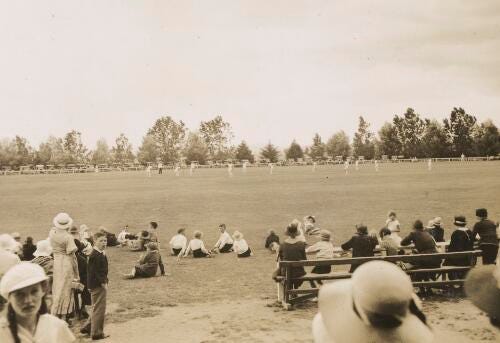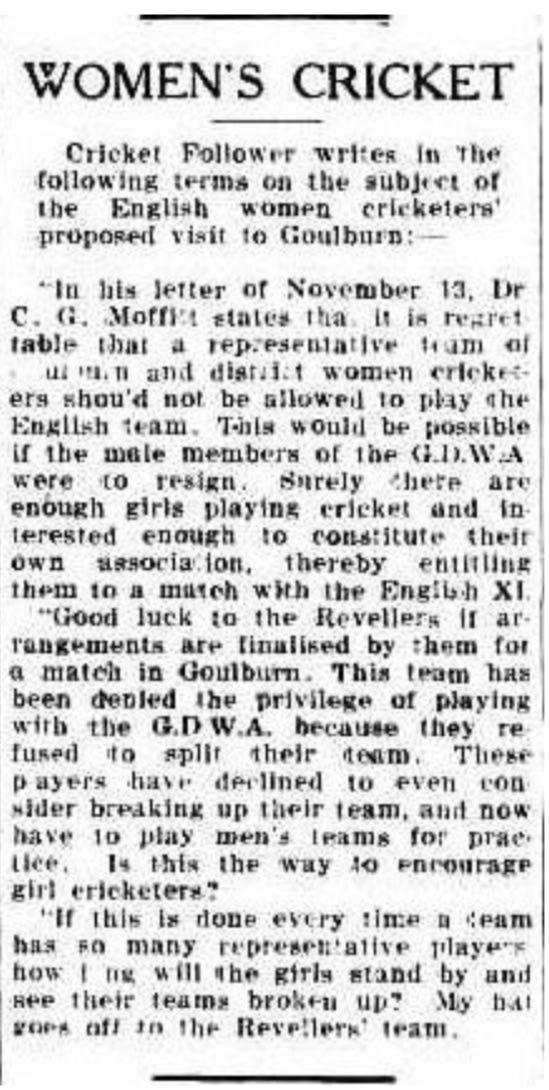Concrete wickets on the country tour
History Makers—Part XL: Reflecting on the Country Games (2)
England had covered half of Australia by the time they triumphed over New South Wales at the Sydney Cricket Ground, where they encountered the batting prowess of Hazel Pritchard. On their journey north to Queensland for the final state match and the opening Test, they paused for day games in Wollongong and Newcastle.
Playing on concrete
18th December 1934
Wollongong Women v England Women at Lysaght Oval, Wollongong. England 9-110 ( DM Turner 32, GA Morgan 31, DE Moorcroft 5-25) drew with Wollongong 6-44 ( P Martin 13*, RA Monaghan 10, JE Partridge 3-11)
England Stumble
Here England encountered a concrete wicket for the first time. The home side bowled tightly in the opening overs, conceding only three singles. Morgan hinted at acceleration with two fours off Lamont, but the momentum shifted when 18-year-old Dot Morecroft dismissed Maclagan, caught by Blade, leaving England at 1-11. Morgan regained control, capitalizing on weaker bowling as Morecroft continued to impress. A mini-collapse followed—Child was run out for eight before Morecroft bowled both Partridge and Archdale. England briefly steadied, but Hannan lured Morgan into a catch by Blake, reducing them to 5-56. Turner and Liebert counterattacked before Moorehead’s return proved decisive, claiming 5-25 as England declared at 9-110. Had they misjudged their timing, or was Wollongong poised for a historic victory in the final 75 minutes?
Wollongong hold on for a draw
Rosy Monaghan, a former Gladstone Ladies Cricket Club player, had impressed for New South Wales the previous week. The team, featuring Morecroft, comprised seven local players alongside four who had represented NSW. After a steady start, Turner’s catch dismissed Monaghan, extinguishing any realistic hopes of victory. The match drifted toward a draw, though Partridge made an impact with three wickets before the close.
Wollongong, who performed well in the match, had made a significant contribution to women’s cricket history in the area. They had competed in the Illawarra District Competition in the 1930s.
Kippax Matting
In her tour diary, Archdale noted, “The ball bounced queerly and the ground off the wicket was very rough, we were in constant danger of spraining our ankles as we had been taught to run off the wicket” (Women’s Cricket, May 1935).
Many Australian grounds featured concrete wickets, typically covered with matting of varying quality. Kippax matting, developed in 1925 (Arrow, Sydney, 3 July 1925), was associated with former Australian Test batter Alan Kippax, whose career suffered a setback in 1931 when he broke his nose after a ball struck a spike on a matting wicket.
Miscommunication at Newcastle Station
19th December 1934
Newcastle Women v England Women played at No 1 Sports Ground, Newcastle.
England 1-184 (ME Macglagan 103*, GA Morgan 78*, G Marks 1-32) drew with Newcastle 6-33 (S Hocken 7, M Hide 3-, Macglagan 3-11). Hours of play: 12:45-1:17, 1:55- 4:00, 4:15-4:55. Rain stopped play between 2:33-2:44 and curtailed play at 4:55, 35 minutes before the scheduled close of play.
England arrived leisurely by train at noon, expecting an afternoon start. However, a miscommunication left Newcastle’s delegation frustrated—they had anticipated the tourists on the 11:15 train for a midday start. Hastily ushered to the ground, the players began the match 45 minutes late.
Newcastle won the toss and sent England in to bat. Progress was slow, but Morgan and Maclagan forged the tour’s highest opening stand, adding 179. Marks was Newcastle’s lone successful bowler, dismissing Morgan for 78. England declared shortly after Maclagan reached her century.
The team rounded off the evening with a dinner dance before boarding the night train to Brisbane for the final state match and the first encounter with the Australian XI.
Brisbane to Melbourne
England secured the first two Tests with ease. Though the series was lost, the Australians were determined to make a statement, with several positions still undecided. The selectors made it clear that performances in the interstate carnival would weigh heavily in selection decisions. As Australian players vied for places, the tourists journeyed to Melbourne for the final Test, pausing for four all-day matches along the way, much to the delight of enthusiastic crowds.
Rain saves Canberra
9th January 1935
Canberra v England at Manuka Oval
Canberra 72 (J Twemlow 14, R Connelly 14, M Moore 12, M Maclagan 6-17) drew with England 1-47 (EA Snowball 26, R Connelly 1-9, M Moore 1-14)
When rain washed out day two of the Sydney Test, an extra day was added to the schedule—securing an England victory but sacrificing a leisurely journey to Canberra. The team arrived on the early morning train, weary from the disruption. In her tour diary, Betty Archdale remarked, “Our energy was fading rapidly. We laughed when the press described our fielding as quick and brilliant.” She wryly added that the Canberra players held their bats like croquet mallets (Women’s Cricket, June 1935).
The home side was dismissed for 72, with Maclagan claiming six wickets. England appeared poised for victory, but the rain returned, forcing the match to be abandoned as a draw.
Goulburn revels, but it could have been a different story
11th January 1935
Goulburn Revellers at Goulburn Sports Ground
England 6-248( EA Snowball 82, ME Hide 64, HE Archdale 38, B Sansom 2-17, J Davey 2-45 ) and 3-83 ( M Richards 49, C Valentine 19) defeated Goulburn Revellers 49( L Peterson 16 *, B Doherty 13, DM Turner 4-7, J Liebert 2-2, CM Valentine 2-7) and 4-38 ( D Large 12, P Johnson 12, J Partridge 4-12) by 199 runs. Please note: the second innings scores were not included in the tour averages.
England secured victory by 199 runs in the first innings, but the match might have been closer had the Goulburn Women's Cricket Association (WCA) resolved its dispute with the New South Wales Women's Cricket Association (NSWWCA). The Goulburn WCA had been granted a fixture against the touring England side, but complications arose when their bid for affiliation with the NSWWCA was rejected. The NSWWCA maintained that male officials could not hold positions, believing women were fully capable of managing their own affairs. In response, a local group formed an association composed entirely of female officials to organize the match. However, the NSWWCA refused to recognize it, dismissing it as a nominal entity.
Meanwhile, the Revellers had been expelled from the Goulburn District Women's Cricket Association (GDWCA) the previous season. Although the Revellers were the strongest team in the local league, the GDWCA aimed to diversify competition by redistributing players among different clubs. When the Revellers attempted to renew their membership at the start of the season, they were denied. Instead, they sought fixtures against men's teams and joined the NSWWCA.
Future Australian captain and NSWWCA secretary Margaret Peden attempted to mediate, but to no avail. Ultimately, the Revellers were awarded the match against England.
A brass band greeted England as their train rolled into Goulburn station at 10 p.m. on the eve of the match. Another civic reception followed the next morning before play commenced at 11 a.m.
England won the toss and opted to bat, delighting a crowd of over 1,000 with fluent stroke play. By lunch, they had raced to 5-201 in just 113 minutes, eventually declaring at 248. Snowball and Hide dazzled with run-a-minute innings, each striking 11 fours in scores of 82 and 64, respectively. Revellers’ captain, B. Samson, was the standout bowler with 2-17.
Peterson and Doherty opened the batting at 2:22 p.m. The English bowlers proved a class above, but the pair took the score to 17 before Turner bowled Doherty. Wickets fell steadily, including Bryant, who batted courageously with a broken nose. Yet England could not dislodge Peterson, who carried her bat for 16.
Both sides batted again, entertaining the crowd further. Following more speeches at the Liedertafel Hotel, the team boarded the night train to Leeton, where they would play an afternoon match the next day.
Leeton
12th January 1935
Leeton Women v England Women (Leeton 14 players, England 11)
Hours of play 2:45-5:10. Leeton Women 25 ( V Treweek 7, J Liebert 3-2, C Valentine 3-5, J Partridge 3-5) and 8-28 ( E Southgate 13, Partridge 2-4, Valentine 2-8, DM Turner 2-8 ) drew with England 1-108 declared ( J Liebert 55, EM Child 27, V Treweek 1-36 ). England won on first innings.
The English team arrived on the midday train for their penultimate civic reception. On a sweltering day—likened by Betty Archdale to Colombo—over a thousand spectators gathered beneath palm trees to watch the match.
Leeton XIV won the toss but labored to 25 in 72 minutes. England entertained another sizable crowd before declaring at 108, losing Elizabeth Child for 27—bowled by Vera Treweek, one of three sisters who would later represent Junee and District in England’s final country town match.
Leeton batted again but struggled to 8-28 at stumps. Archdale noted that intervals were enlivened by an excellent local band, while a grandstand half-filled with shrieking boys added to the spectacle (Women’s Cricket, June 1935).
The Junee team, including three Treweek sisters
15th January 1935
Junee and Districts v England Women
Junee and Districts 29 ( M Treweek 8, E Jones 7, M Maclagan 4-6) and 23 ( V Treweek 11, E Treweek 7, Maclagan 6-12, ME Hide 4-11) lost to England 63 (EM Child 14, ME Richards 13, G Weissell 3-10, M Treweek 3-11, M Treweek 3-18 ) and 63-1 ( GA Morgan 32*, H E Green 30*). England batted on after winning.
A large crowd welcomed England as they arrived on the 6:15 train the evening before the match. After spending the night at the pictures, they attended a final country-town civic reception before the game, which had been declared a public holiday (The Bodyline Fix, Stell). An enthusiastic gathering of around two thousand greeted the team as they stepped onto the ground.
Junee won the toss and chose to bat but struggled on the new turf wicket, managing just 29 in 31.5 overs. The backbone of the local side was the Treweek sisters—Vera, Mary, and Elma—each accomplished in both cricket and district tennis, alongside G. Weisell, sister of football star Eric. Vera’s reputation in both sports was already well established, having scored centuries and taken wickets across multiple seasons.
When England batted, Vera and Mary opened the bowling, claiming three wickets apiece. Meanwhile, Elma kept wicket, taking two catches and stumping Grace Morgan. Vera had recently been selected for Sydney trial matches, showcasing the depth of talent beyond the major cricketing centres.
Hospitality
Betty Archdale’s team faced a demanding schedule as they toured Australia, not only representing their country but also championing women’s cricket. While the country matches were not the most competitive, they showcased the sport’s quality, inspiring more women and girls to take it up and aiding local players’ development.
Australian hospitality was beyond question, with each venue offering day trips and a flurry of civic receptions. Understandably, many wished to express their gratitude, but the sheer number of speeches could be exhausting. On a scorching day in Junee, the team endured 21 speeches before play even began.
Archdale and Green were excellent speakers, but they had as few mishaps, as explained in manager Betty Green’s tour diary.
Statistics
An immaculate scorebook had been kept throughout the tour with detailed records of individual performances.
References
While writing about the tour, extensive references were made to Women’s Cricket History and the Trove Collection.
Book recommendations
For more information about the tour, the following books are highly recommended.
The Bodyline Fix: How Women Saved Cricket (Marion Stell, 2022)
Captain’s File: From Peden to Haynes: Australia's Women's Test Cricket Captains (Rob Harvey, 2022)












